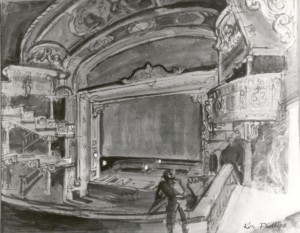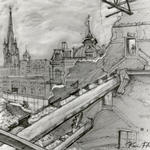 Stage within, stage without. Not only did my father love the grand old theaters of Toronto, but he was forever searching for ways to include performance in his own life. When he built their studio in 1940, it seemed natural to him to include the beginnings of a small, curtained stage between the giant yellow-varnished bamboo pillars which upheld the balcony part of the staircase to the upstairs bedrooms. The long landing half-way up the stairs doubled as a balcony, and he had entrances planned to each side of the little stage area itself.
Stage within, stage without. Not only did my father love the grand old theaters of Toronto, but he was forever searching for ways to include performance in his own life. When he built their studio in 1940, it seemed natural to him to include the beginnings of a small, curtained stage between the giant yellow-varnished bamboo pillars which upheld the balcony part of the staircase to the upstairs bedrooms. The long landing half-way up the stairs doubled as a balcony, and he had entrances planned to each side of the little stage area itself.
Art-making was performing. He knew that. Ever since the days when he had been a boy magician on the stages of church halls, impressing his audiences with the quick sketches which changed a cat to a boy to a tree all within a few strokes, he had understood that. It seemed as necessary for him to have a theater in the home as a meditation center might be for others. Although my father could fiercely guard his privacy, he was conscious of a responsibility to entertain and inform the crowds that inevitably gathered when he was sketching in Toronto.
 At the time that he built his Harborn stage, he still anticipated that friends and associates from his Toronto experiences would be a part of his life there, likely improvising charades or acting scenes from his beloved Dickens. Sadly, he never found a way to create the entertainments he envisioned. Still, so intrinsic were dramatics to him that when he was in his late sixties, his plans for his later home in eastern Ontario quite unjustifiably included a massive stage in one of the outbuildings.
At the time that he built his Harborn stage, he still anticipated that friends and associates from his Toronto experiences would be a part of his life there, likely improvising charades or acting scenes from his beloved Dickens. Sadly, he never found a way to create the entertainments he envisioned. Still, so intrinsic were dramatics to him that when he was in his late sixties, his plans for his later home in eastern Ontario quite unjustifiably included a massive stage in one of the outbuildings.
